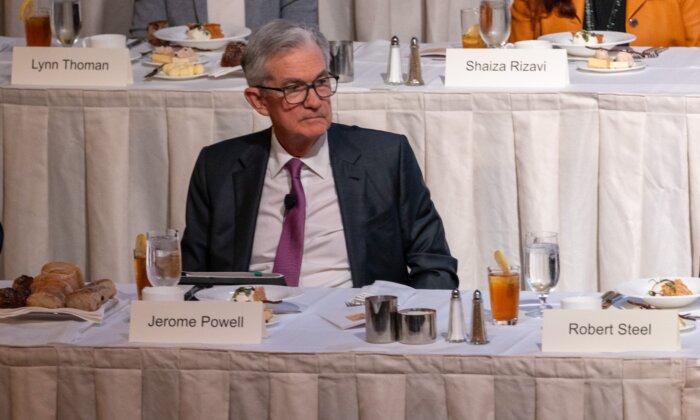Federal Reserve Chair Jerome Powell hinted that there will be no rate increase at next month’s Federal Open Market Committee (FOMC) policy meeting, but left the door open to further tightening if it is warranted.
Financial markets paid close attention to Mr. Powell’s appearance at the Economic Club of New York on Oct. 19, combing through his remarks to determine the trajectory of interest rates.
The head of the Federal Reserve refrained from outlining a specific monetary policy path but hinted that the central bank is finished raising interest rates. Still, the Fed chief asserted that the institution must remain vigilant to accomplish its twin objectives of price stability and maximum employment.
Price inflation remains high, and below-trend economic growth might be required to achieve the U.S. central bank’s 2 percent target, he stated.
“Inflation is still too high,” said Mr. Powell, acknowledging that it is unclear as to how long lower inflation readings will last.
He also warned that the U.S. economy would need to post below-trend growth and additional softening of labor market conditions. However, the Fed chair argued that the U.S. economy might be more immune to a climate of higher interest rates than in the past.
In September, the annual inflation rate was unchanged at 3.7 percent following two consecutive months of increases. The economy also added a better-than-expected 336,000 new jobs. Additionally, various estimates suggest that the third-quarter growth rate of gross domestic product will be between 4 percent and 5 percent.
“Overall, firms expect prices to increase the next few quarters, but at a slower rate than the previous few quarters,” the monthly report stated. “Several districts reported decreases in the number of firms expecting significant price increases moving forward.”
Some economic observers pushed back against Mr. Powell’s recommendation of a slower economy.
State of Interest Rates
Mr. Powell noted that he does not believe interest rates are too high, although he agreed that a rising-rate environment is “difficult for everybody.”“Does it feel like policy is too tight right now? I would have to say no,” he told Bloomberg’s David Westin.
The full effects of rate hikes since March 2022 have yet to be felt, alluding to the concept that monetary policy functions with lags, which was made famous by eminent economist Milton Friedman. For the past 20 months, the central bank has raised rates by 500 basis points.
But while there is a risk of the Fed doing too much, Mr. Powell contended that this might be necessary, considering the ongoing risks and uncertainty.
“Given the uncertainties and risks, and given how far we’ve come, the committee is proceeding carefully and will make decisions about the extent of policy firming, and how long policy will remain restrictive based on the totality of the incoming data, evolving outlook,” he said.
Market Reaction
His remarks hit all the right points as he signaled a rate pause next month and alluded to another rate increase should growth and inflation not moderate, says Scott Anderson, the chief U.S. economist at BMO Capital Markets.“The Powell speech, while keeping his options open, did little to change our view that the Fed will pause their rate hikes again at the upcoming Oct 31-Nov. 1 FOMC Meeting,” Mr. Anderson wrote in a note. “They still believe the economy will slow despite a surprisingly strong third quarter. With Fed policy now firmly in restrictive territory, a strong case can be made to take a wait-and-see approach, until we get more clarity on the economic and inflation outlook.”
The U.S. stock market teetered between positive and negative territory as investors attempted to digest Mr. Powell’s economic speech.
Treasury yields were mixed amid a divergence between short- and long-term bonds. The 2-year yield slipped below 5.44 percent. The benchmark 10-year yield picked up more than 6 basis points to nearly 4.97 percent. The 30-year bond firmed close to 8 basis points to above 5.07 percent.
Mr. Powell purported that the latest volatility in the U.S. Treasury market was driven by a combination of factors, including investors revising their opinions about the strength and resilience of the national economy “and thinking even longer-term may require higher rates.” He added that there could also be “a heightened focus” on federal deficits, noting that the current fiscal path is “unsustainable.”
But he rejected the notion that the financial markets are bracing for higher inflation.
Reiterating what some other Fed officials have said, including Minneapolis Fed President Neel Kashkari, Mr. Powell averred that rising Treasury yields might help some of the Fed’s aims.
“Financial conditions have tightened significantly in recent months, and longer-term bond yields have been an important driving factor in this tightening,” he said.
Did Too Much
Looking back at the coronavirus pandemic, Mr. Powell and his colleagues assessed the landscape and saw that the virus resulted in many deaths and that a vaccine would not be developed for five years.“We pulled out all the stops,” he said. “With a benefit of hindsight, could we have done a little bit less and had a little bit of inflation? I guess we could.”







